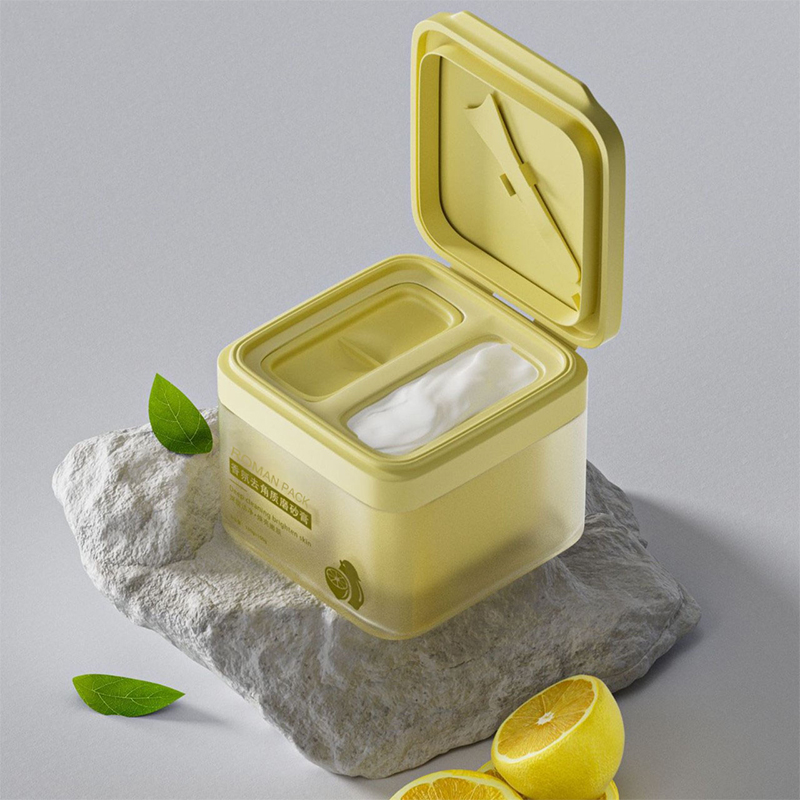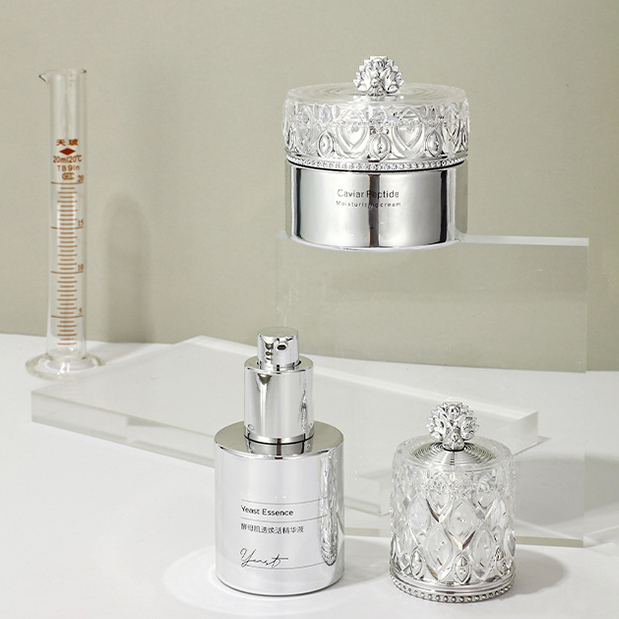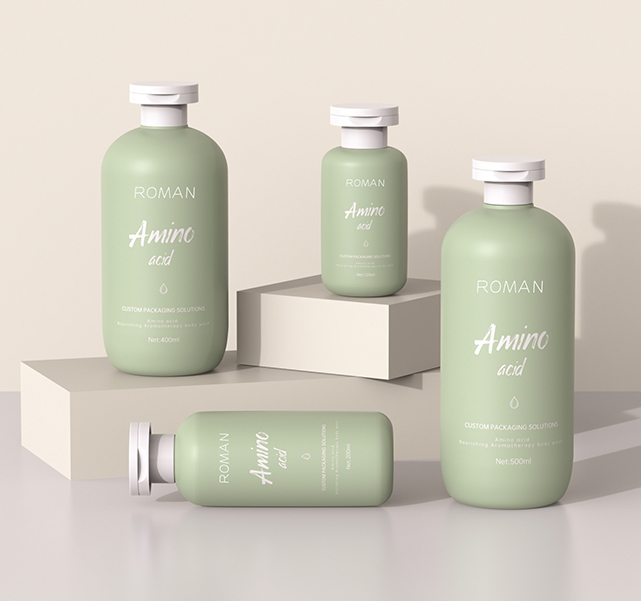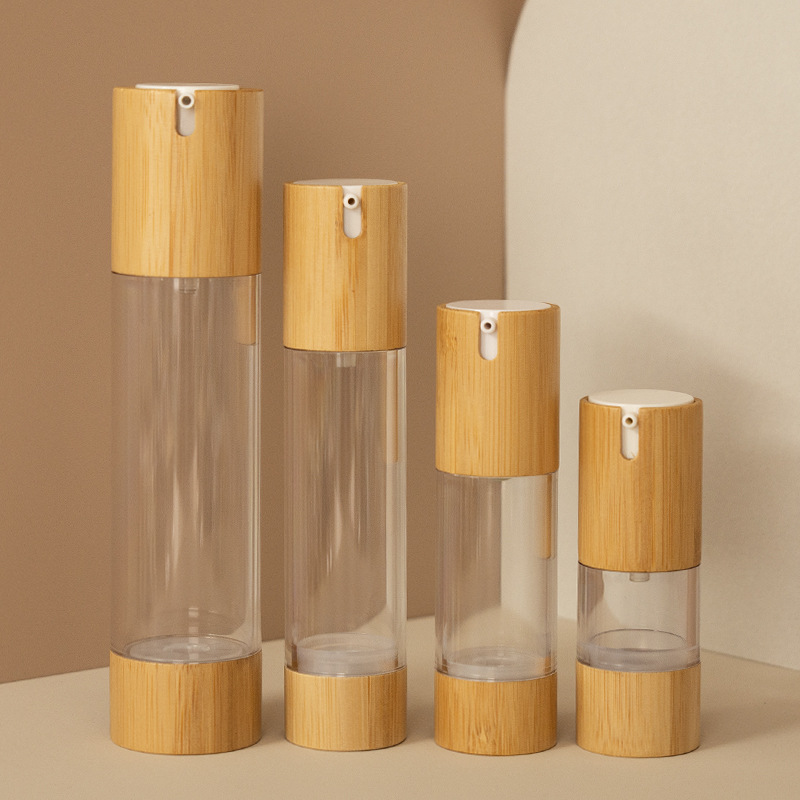Is it suitable for daily skin care use
Natural materials: bamboo's renewable characteristics and environmental advantages
As a fast-growing and resource-rich plant material, bamboo has obvious advantages in the field of environmentally friendly packaging:
*Short growth cycle: bamboo only takes 3-5 years from planting to harvesting, and has a higher regeneration efficiency than other woods;
*Relatively environmentally friendly processing: Compared with some synthetic materials, bamboo does not require a large amount of chemical additives during processing, and has a lower carbon footprint;
*Degradability: Bamboo products can be naturally degraded under natural conditions, reducing the burden of discarded packaging on the environment.
For daily skin care use, choosing a bamboo bottle means supporting a more environmentally friendly lifestyle while using every skin care product.
Product adaptability: What skin care products are bamboo bottles suitable for?
Bamboo cosmetic bottles are usually used in combination with liners (such as PP, PETG, glass, etc.) to enhance sealing and chemical resistance. The following types of skin care products are more suitable for bamboo packaging:
*Lotion products: products with thicker textures such as body lotion and face cream can be paired with a pump or screw cap;
*Essence and beauty oil: paired with a glass or plastic liner, it can not only protect the stability of the formula, but also have the natural appearance of bamboo;
*Facial cleansing products: bamboo packaging bottles with flip caps or pump heads are helpful for daily use;
*Lipstick and solid balm: small bamboo containers can be used for single products such as lipstick and lip balm, which are easy to carry.
It should be noted that for products with high concentrations of active ingredients or strong pH, the liner material should be compatible with the contents to avoid reactions or leakage.
User experience: What are the concerns of consumers in daily skin care?
From the user's perspective, the following is the performance of bamboo cosmetic bottles in daily skin care scenarios:
*Natural grip
Bamboo has a warm touch and is not easy to slip in dry or humid environments, making it more comfortable to use.
* Gentle visual effect
The unique texture of bamboo surface often gives people a gentle and natural impression, which helps to enhance the overall temperament of the product and is suitable for skin care experience that focuses on ritual.
* Moderate weight
Compared with glass bottles, bamboo bottles are lighter and easier to carry, suitable for use when going out or traveling.
* Maintenance needs attention
Bamboo bottles are prone to water absorption and deformation in humid or high temperature environments. It is recommended to avoid long-term soaking or exposure. The exterior of some products may be treated with paint or wax to enhance durability.
Some suggestions for the use of bamboo bottles
In order to better extend the service life of bamboo cosmetic bottles, the following suggestions are worth referring to:
* Regular cleaning: Keep the bottle mouth and pump head clean to prevent contamination caused by residual skin care products;
* Avoid frequent drops: Although bamboo has a certain toughness, it is slightly less resistant to falling than plastic, so try to avoid drops;
* Store in a dry place: Please dry the bottle after use and avoid long-term placement in humid environments such as bathrooms;
* Check the sealing: Check the sealing of the pump head and bottle cap regularly to prevent air from entering and affecting the contents.
Combination of applicability and environmental protection concept
Bamboo cosmetic bottles are a more suitable choice for daily skin care, especially for products with mild texture and low volatility. They are attractive in terms of user experience, environmental protection attributes and visual design. However, when purchasing, attention should still be paid to the liner material, safety and actual formula requirements to ensure the matching of packaging and contents.
As consumers pay more attention to sustainable packaging, bamboo bottles are not only a packaging choice, but also represent a life attitude. If a balance can be found between functionality and aesthetics, bamboo cosmetic bottles will occupy a place in daily skin care.
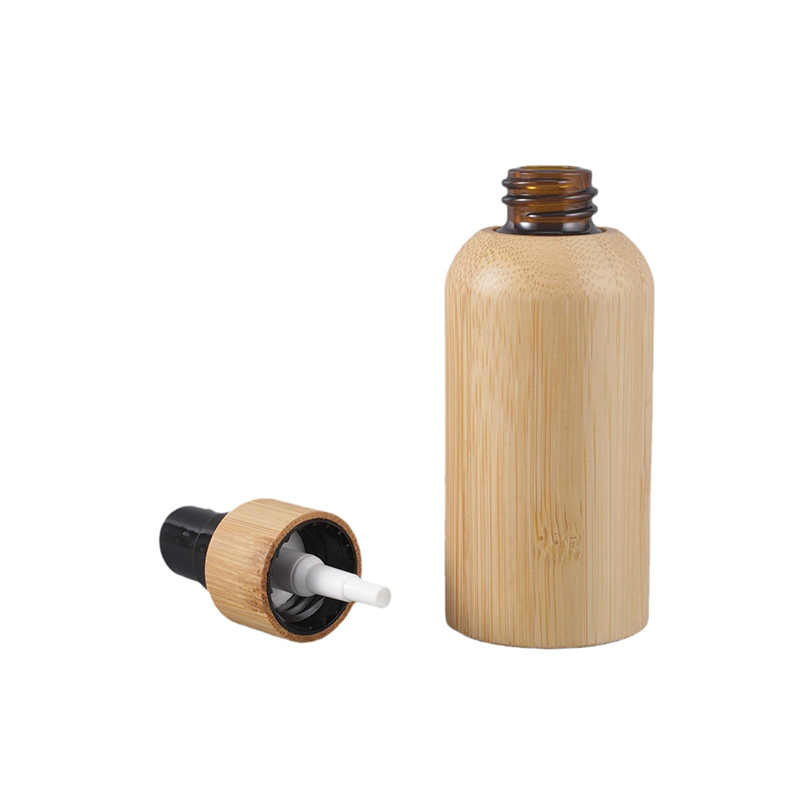 |
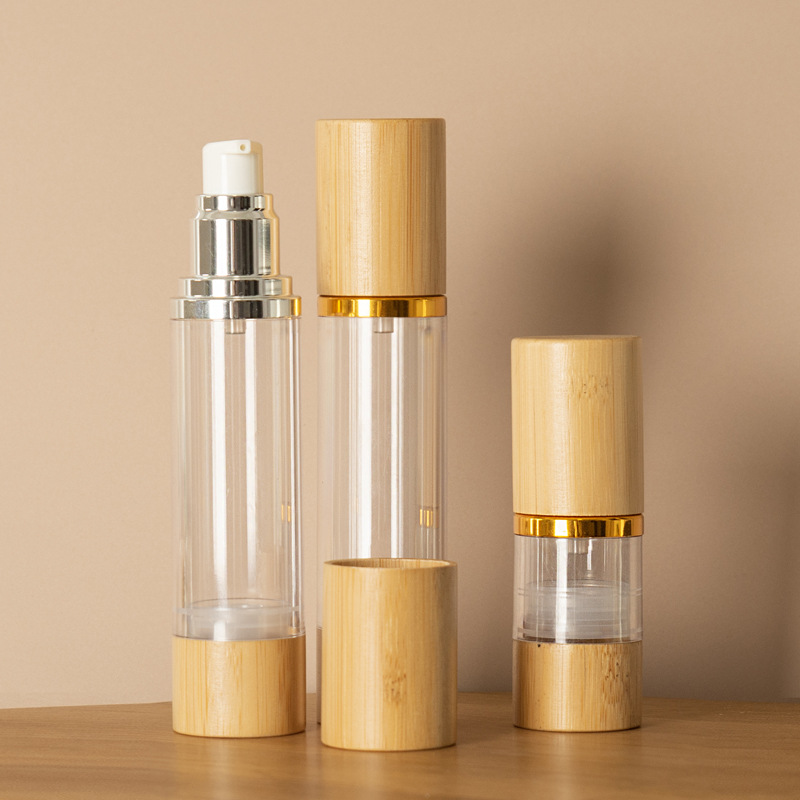 |
Is it environmentally friendly
Natural properties and regeneration of bamboo
1. Fast-growing natural resources
Bamboo is a perennial plant with an extremely fast growth rate. Under suitable climatic conditions, a bamboo can grow more than 30 cm a day, and some varieties can be mature within a few months. This feature makes bamboo one of the most renewable plant resources.
2. Harvesting and replanting do not require high costs
Bamboo usually does not need to be replanted after felling, and its underground roots can naturally sprout new bamboo, which greatly reduces the environmental burden caused by artificial planting and farming.
3. No reliance on large amounts of pesticides and fertilizers
Unlike some crops, bamboo has a lower demand for land and pesticides, and has relatively little interference with the ecology during the planting process.
From the perspective of the sustainability of raw materials, bamboo itself has certain environmental protection potential and is one of the alternatives to plastic or some metal packaging.
Environmental impact of the production process of bamboo cosmetic bottles
Although bamboo is a natural resource, the processing process from raw bamboo to finished products still involves multiple links:
1. Energy consumption in the processing link
Bamboo needs to go through steps such as cutting, carbonization, polishing, and mildew-proofing. Some of them will also use mechanical or chemical methods to enhance durability. Although these links are more natural than the manufacturing process of petrochemical plastics, they still require energy input.
2. Combined with composite liner structure
Most bamboo cosmetic bottles are often equipped with glass or plastic liners to ensure sealing and content safety. Such composite structures are difficult to separate during the actual recycling process, which may reduce their overall recycling efficiency.
3. Surface treatment may increase non-degradable components
In order to improve the aesthetics and waterproofness of the product, some bamboo bottles will use paint or film technology on the outside. If such surface materials are non-degradable, it will also affect the overall environmental performance.
Although bamboo has environmental advantages as an outer shell, the environmental performance of the overall product still needs to be comprehensively evaluated in combination with supporting materials and processes.
Use cycle and durability
Bamboo cosmetic bottles are stable during use, especially suitable for home, travel or repeat purchase products:
1. Balance of strength and weight
Bamboo is lighter than glass and harder than plastic, taking into account portability and sturdiness, and is suitable for packaging of products with various textures such as lotions, essences, and balms.
2. Reusable
Some bamboo bottles can be reused after cleaning, reducing the waste of resources caused by disposable containers. However, whether it has the function of disassembly and replenishment still depends on the specific product design.
3. Note that moisture resistance
Although it has been treated with moisture-proof, the bamboo material itself is still susceptible to moisture or mold, so it is still necessary to be careful when using and storing it in a humid environment to avoid long-term high humidity.
In terms of daily use, bamboo bottles can meet the packaging needs of most skin care products in terms of function, and have the potential for reuse under certain conditions.
Feasibility of recycling and treatment methods
Environmentally friendly packaging should not only consider the source of resources before use, but also evaluate the recycling and treatment methods after use:
1. Natural materials are degradable
Pure bamboo materials that have not been excessively chemically treated can gradually degrade in the natural environment and will not remain in the ecosystem for a long time.
2. Mixed materials are difficult to recycle
If bamboo is closely combined with plastic and glass, it is difficult to separate them, and manual processing is often required, which increases the burden on the recycling system. This also means that some bamboo bottles may eventually be treated as mixed garbage.
3. Depend on consumers' recycling awareness
In order for bamboo bottles to truly achieve environmental benefits, consumers must have a certain level of environmental awareness, such as correctly classifying and discarding or reusing them.
If the product can be more easily disassembled and classified at the beginning of the design, it will help improve the environmental efficiency of its back-end processing.
Environmental protection is a balance and choice
Bamboo cosmetic bottles show good environmental protection potential in terms of material sources, visual performance and reusability, especially in line with the current consumer market's expectations for natural and environmentally friendly packaging. However, whether it is truly environmentally friendly still needs to be comprehensively evaluated from the perspective of the entire life cycle, including energy consumption in the production process, difficulty in handling composite structures, and consumer recycling behavior.
Under the general trend of sustainable development, bamboo bottles are not the only choice, but they are indeed a new direction worthy of attention. For brands, optimizing design, reducing the use of mixed materials, and providing recycling solutions are the key to improving their environmental value; for consumers, understanding the ecological impact behind packaging and making rational choices and use are important steps to achieve environmental protection goals.
| Zero Waste More Care |
|
Reuse |
Reduce |
Replace |
Recycle |
Daily maintenance and storage suggestions
Correct use is the premise of extending the lifespan
1. Avoid frequent and violent collisions
Although bamboo is less likely to break than glass, its surface is prone to dents or cracks due to collisions. Especially when traveling or using it outside, it is recommended to put the bamboo bottle in a soft storage bag or a bag with compartments to reduce external impact.
2. Keep it dry when opening and closing
When using a bamboo bottle, try to avoid opening and closing it repeatedly when the bottle mouth is wet. Moisture may penetrate into the gap of the bottle cap, and long-term accumulation will accelerate the deformation or mildew of the bamboo.
3. Check the fastening of accessories regularly
If the bamboo bottle is equipped with a metal pump head, glass liner and other components, it is recommended to check whether its threads or bayonet are firm regularly to prevent slippage or leakage during use.
Cleaning methods should be gentle and moderate
1. Use a soft cloth to wipe gently
The surface of bamboo should not be cleaned with a rough or hard brush. It is recommended to use a soft dry cloth or a slightly damp cloth to gently wipe the surface to remove dust and fingerprints. Try to avoid soaking and cleaning to prevent moisture from penetrating and causing swelling or degumming.
2. Neutral detergent can be used moderately
If there are oil stains or cosmetic residues, use diluted neutral detergent to wipe. After cleaning, wipe dry immediately to avoid residual moisture forming water stains or mildew on the surface of the bottle.
3. Dry and ventilate regularly
It is recommended to place the bamboo bottle in use in a ventilated place to dry naturally every one to two weeks, especially in seasons with high humidity, which helps prevent moisture accumulation and mold growth.
The storage environment should be away from light and moisture
1. Avoid direct sunlight
Long-term exposure to sunlight may cause the surface of the bamboo to crack, fade or deform. Please store the bamboo bottle in a cool place to avoid direct exposure to strong ultraviolet rays.
2. Keep dry and ventilated
Bamboo products are most afraid of moisture. It is recommended to avoid storing bamboo bottles in the bathroom, sinks near water sources or confined spaces for a long time. You can choose dry and ventilated drawers, cosmetic storage racks or storage boxes for centralized management.
3. Use moisture-proof agent or desiccant bag
In wet seasons or humid environments, a small amount of desiccant or silica gel bag can be added to the storage area to reduce air humidity and further protect the bamboo from water vapor erosion.
Avoid common usage errors
1. Mistakenly use bamboo bottles as waterproof containers
Because bamboo itself has a certain water absorption, even after moisture-proof treatment, it is not suitable for long-term contact with liquids or frequent inversion when used to store liquid skin care products (such as makeup removers and essences). It should be kept vertically to avoid liquid backflow.
2. Ignore the "breathability" of bamboo
Bamboo naturally has a microporous structure and has a certain air permeability, which is different from a completely sealed plastic bottle. Therefore, under high temperature or closed conditions, pressure fluctuations in the bottle may affect the stability of the appearance and even cause the bottle cap to loosen. When using, avoid placing it in a high temperature environment, such as near hair dryers, electric heaters and other equipment.
3. Irregular cleaning leads to accumulation and pollution
Some users are accustomed to using bamboo bottles for a long time to replenish a single product, but ignore the importance of regular internal cleaning. Even if the bottle is filled with glass or plastic liner, the outer bamboo material needs regular care to extend the overall use time.
Extending the life of bamboo bottles requires a combination of use and maintenance
Bamboo cosmetic bottles achieve a natural balance between functionality and aesthetics, and are a positive attempt under the current trend of environmentally friendly packaging. Its service life is not short, but users need to pay appropriate attention and maintenance measures in daily life. By avoiding violent collisions, keeping dry and ventilated, properly cleaning and storing properly, the use cycle of bamboo bottles can be effectively extended and the appearance can be maintained in good condition.
Consumers can also choose whether to reuse bamboo bottles according to the frequency of use. Some high-end cosmetics brands have supported the secondary replenishment function of bamboo bottles, extending environmental protection from "material selection" to "usage mode", which is of positive significance to achieving true sustainable development. At the moment of advocating a green lifestyle, learning to properly maintain bamboo cosmetic bottles not only helps save resources, but also reflects respect for natural materials and recognition of ecological concepts.
New applications in beauty packaging
Materials return to nature: Sustainable advantages of bamboo
1. Renewable resources
As a natural plant that grows fast and does not require pesticides or fertilizers, bamboo is highly competitive among environmentally friendly materials. Compared with wood, it has a short life cycle and a high renewal rate. It can be harvested and replanted in a short time, reducing pressure on the ecosystem.
2. Low carbon footprint
Bamboo has a strong carbon fixation ability during its growth. Using bamboo as a packaging material helps to reduce the carbon emission level of the entire product life cycle and meets the green packaging standards.
The design style is natural and simple, in line with the aesthetics of beauty
Bamboo packaging injects a natural atmosphere into cosmetic products with its natural texture and warm texture, which is in line with the current popular concepts of "no additives", "pure skin care" and "plant sources".
1. Diversified design applications
Modern processing technology allows bamboo bottles to be matched with a variety of materials such as glass liners, metal nozzles, plastic pump heads, etc., to achieve a combination of practicality and aesthetics. The exterior can also be customized with brand logos through laser engraving, hot stamping, screen printing, etc.
2. Simple but not monotonous
Compared with traditional plastic bottles with bright colors and complex patterns, bamboo bottles tend to emphasize the natural beauty of the material itself, which is suitable for creating a "simple" and "original" style product visual system.
Product types are expanded and the application field is wide
Bamboo cosmetic bottles are no longer limited to a single packaging form, and more and more beauty products are beginning to introduce this material.
1. Applicable to a variety of skin care products
Including face cream bottles, essence bottles, eye cream bottles, lotion pump bottles, air cushion shells, etc., bamboo can be used as the outer shell to enhance the overall texture.
2. Packaging upgrade of makeup tools
In addition to skin care bottles, bamboo is also widely used in tool products such as makeup brush handles, powder puff boxes, and mask sticks, further expanding its application range in the cosmetics field.
Structural innovation that takes into account both function and environmental protection
1. Replaceable liner design
Some brands have developed bamboo bottles with replaceable glass or PP liners. Users do not need to replace the entire bottle after use, but only need to replace the contents of the liner. This structure not only extends the service life of the outer shell, but also reduces packaging waste.
2. Lightweight and protective
The weight of bamboo is between glass and plastic, suitable for small and medium-sized packaging. It also has a certain pressure resistance, which helps protect during transportation.
Consumer awareness is improving, and acceptance is gradually expanding
1. Sustainable consumption awareness is increasing
More and more consumers will pay attention to whether the product packaging is environmentally friendly when choosing skin care products. The natural image of bamboo bottles can often convey the brand's environmental protection concept at the first time.
2. Adapt to the dual scenes of e-commerce and offline display
Bamboo cosmetic bottles have natural visual appeal and are suitable for use in e-commerce platform picture displays and offline physical displays, bringing differentiated visual memory points to the products.
Challenges and coping directions
Although bamboo cosmetic bottles have many advantages, they still need to face some practical problems:
1. Slightly higher cost
Compared with plastic, bamboo has higher raw material and processing costs, especially manual polishing, custom engraving and other processes, which will increase the production cycle.
2. Adaptability to humid environments
Bamboo itself is sensitive to humidity. To improve durability, manufacturers usually apply environmentally friendly paint or carbonize the surface, which requires high technical requirements.
3. Recycling and classification issues
Bamboo bottles are often made of composite materials, and consumers may need to manually separate them when recycling. In the future, it is expected that structural design optimization will improve recycling convenience.
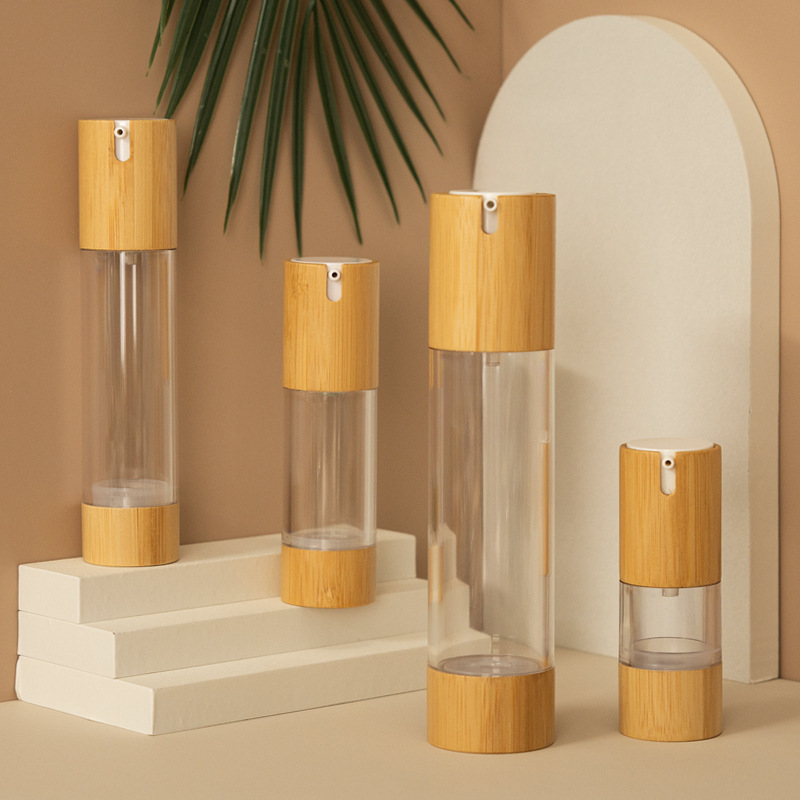 |
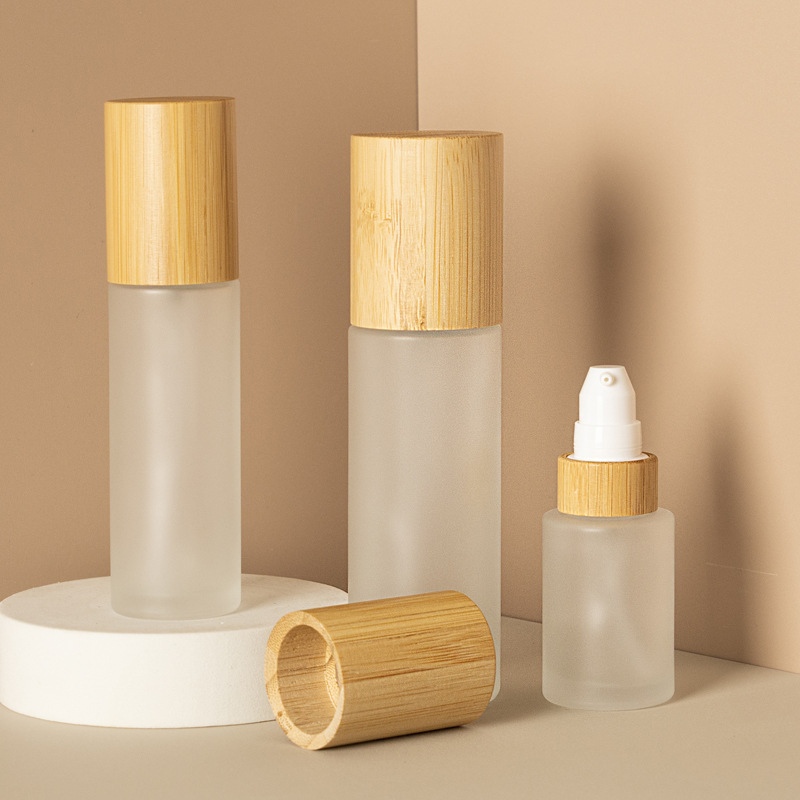 |
Explore market trends
In the contemporary consumer market, product packaging is no longer just a functional container. It is an extension of the brand concept and a presentation of consumer values. As the world's attention to environmental sustainability continues to increase, traditional plastic packaging is being re-examined. In this context, bamboo packaging, as a new material that combines environmental protection properties with visual beauty, has gradually entered the vision of various brands. Especially in the beauty, personal care, home, food and other industries, more and more companies are beginning to use bamboo packaging to increase product added value and convey a sense of responsibility and natural concepts to consumers.
Promotion of environmental protection laws and policies
1. Gradually tightening plastic restriction policies
Many countries around the world have successively introduced plastic restrictions and bans, forcing companies to find alternative materials. For example, the EU's "Green Deal" requires a significant reduction in the use of disposable plastics by 2030; China's "Plastic Ban" has also been implemented in many cities. This policy-level pressure has prompted brands to accelerate their transition to environmentally friendly materials, and bamboo packaging has become one of the viable options as a renewable resource.
2. Carbon emissions and ESG assessment
When companies respond to the ESG (environment, society and governance) evaluation system, the materials used in packaging directly affect their environmental scores. As a biomaterial with strong carbon absorption capacity and short life cycle, bamboo can help reduce carbon footprint and enable companies to perform better in sustainable assessments.
Improvement of consumer environmental awareness
1. "Environmental protection + aesthetics" has become a new consumption trend
More and more consumers not only care about product functions, but also pay attention to their impact on the environment. According to the survey, nearly 60% of Generation Z consumers prefer to buy products with environmentally friendly packaging. The natural texture and rustic appearance of bamboo packaging meet the dual needs of "environmental protection" and "natural aesthetics".
2. Social media communication effect
Many consumers are willing to share the "environmentally friendly packaging unboxing" experience on social platforms. Bamboo packaging is often more attractive for taking photos due to its unique appearance and natural properties. This spontaneous communication has enabled the brand to gain more exposure and accelerated the promotion of bamboo packaging.
Physical and ecological advantages of bamboo itself
1. Renewable and fast-growing
Bamboo is a plant with a short growth cycle, and some varieties can grow more than 1 meter a day. Compared with other woods, it has a short harvesting cycle, fast renewal, and less resource pressure.
2. Natural material, easy to degrade
Bamboo itself is a natural organic matter, does not contain petroleum-based raw materials, and can be degraded after the end of its service life, avoiding the generation of "white pollution".
3. Stable mechanical properties
After processing, bamboo has good strength and stability, suitable for a variety of packaging forms such as bottle shells, boxes, brush handles, and can be used in combination with glass, plastic or metal liners.
Brand image and value expression
1. Conveying sustainable concepts
Brands that choose bamboo packaging often hope to express respect for the environment with the help of natural materials, thereby establishing the image of a "green brand" in the market. This way of expression directly affects consumers' recognition of the brand's value.
2. Create a differentiated competitive advantage
In a highly homogenized market, packaging design has become an important means of differentiation. Bamboo packaging is easy to stand out visually due to its unique material, helping brands to shape a unique positioning.
3. Support local crafts and community economy
Some brands use local or handmade bamboo packaging, which helps promote rural economy and handicraft inheritance, and is also in line with the current trend of socially responsible consumption.
Technological progress improves processing feasibility
1. Mature bamboo finishing technology
The introduction of modern CNC equipment, carbonization treatment and mildew-proof technology has significantly improved the performance of bamboo in terms of moisture resistance, crack resistance and durability, and can meet more complex packaging structure requirements.
2. Composite structure innovation
Bamboo packaging can be composited with glass, PP plastic, metal and other materials to meet multiple functional requirements such as sealing, portability and reusability. The current common "bamboo shell + liner" combination on the market has become one of the mainstream designs.
3. Sustainable printing process integration
The widespread use of environmentally friendly processes such as silk screen printing, laser engraving, and water-based inks has made bamboo packaging no longer limited to primary colors, but also able to achieve diversified brand expression.
Increasingly enhanced supply chain adaptability
1. Bamboo resources are widely produced
Asia, Africa and Latin America are all rich in bamboo forest resources. China, India, Vietnam and other places have formed a relatively complete bamboo product industry chain, providing reliable materials and processing capabilities for global brands.
2. Mature OEM/ODM services
At present, many professional manufacturers have the ability to undertake OEM/ODM orders for bamboo packaging, such as customizing bottle shapes, patterns, structures and functions according to brand needs. This reduces the cost of brand transformation and accelerates the market deployment of bamboo packaging.
Bamboo packaging is not a trend, but a long-term choice
With the tightening of environmental regulations, the improvement of consumer awareness and the continuous optimization of materials and technologies, bamboo packaging has gradually moved from niche exploration to mainstream choice. It not only responds to the global call for sustainable development, but also provides brands with a new communication language and market entry point.
Although bamboo packaging currently still faces challenges in terms of cost, adaptability to humid environments, and recycling systems, these problems are being continuously optimized with industrial collaboration and process innovation. In the future, bamboo packaging may no longer be an "environmentally friendly option", but a basic embodiment of brand responsibility and innovation.
When green packaging becomes a brand consensus, bamboo packaging will not only be a replacement of materials, but a redefinition of the entire value chain ecology. For brands that hope to establish long-term competitiveness in a fierce market, choosing bamboo packaging is a sustainable, perceptible and sustainable path.
Compare the functions of packaging materials
Sources of raw materials and environmental impact
1. Plastic bottles: derived from petroleum resources
Plastics are mainly made from petroleum refining and are non-renewable. The entire production process will produce a large amount of greenhouse gases. If not properly recycled after use, they may flow into the ocean or soil, causing long-term pollution.
2. Bamboo bottles: from natural plant resources
Bamboo is a fast-growing renewable resource with a short harvesting cycle. It does not rely on pesticides and fertilizers during planting and has a strong carbon absorption capacity. Even as waste, its natural decomposability reduces the lasting burden on the environment.
From the perspective of raw materials, bamboo has lower environmental impact and higher sustainability than plastic.
Processing performance and design flexibility
1. Plastic bottles: high-degree-of-freedom molding design
Plastic bottles can achieve complex structures and various bottle shapes through injection molding, blow molding, etc., which are suitable for mass production and customized design, and have high controllability over detail processing and product appearance.
2. Bamboo bottles: mostly composite structure design
Bamboo itself has a certain hardness and toughness, but the processing accuracy is limited. At present, most bamboo bottles on the market adopt the structure of "bamboo shell + plastic or glass liner". Pure bamboo bottles still face technical challenges such as leakproof and mildew-proof.
In terms of mass customization and complex structure realization, the flexibility of plastic bottles still has advantages, and bamboo bottles are suitable for mid-to-high-end positioning or product lines that emphasize natural texture.
Durability and physical properties
1. Plastic bottles: light and not easy to break
Plastic bottles have excellent impact resistance, are not easy to break, are easy to transport and carry, and are widely used in outdoor, travel and other scenes.
2. Bamboo bottles: high hardness, but sensitive to the environment
Although bamboo is strong, it is greatly affected by humidity and temperature. If it is not specially treated, it is easy to absorb water, deform or grow mold. More attention should be paid to use and storage, such as keeping dry and avoiding long-term contact with liquids.
In terms of durability, plastics are more suitable for applications in high frequency, long distance or harsh environments, while bamboo bottles are more suitable for static or household products.
Packaging aesthetics and brand recognition
1. Plastic bottles: strong visual uniformity
Plastic bottles can achieve high-precision surface treatment, such as transparent, high-gloss, frosted and other effects, and support a variety of colors and pattern printing, which is suitable for building a standardized brand image.
2. Bamboo bottles: natural texture and environmentally friendly image
Each texture of the bamboo bottle is derived from natural materials, which has a certain uniqueness and can convey the brand tone of simplicity, ecology and nature. This kind of packaging is frequently used in high-end skin care, organic beauty, aromatherapy and other fields.
Bamboo packaging has more emotional value and visual differentiation, while plastic bottles are more suitable for building a large-scale and unified market image.
Economic efficiency and production cost
1. Plastic bottles: low unit cost, suitable for large-scale production
The raw materials and production equipment of plastic bottles are mature, and the unit price is low. It is suitable for high-sales and high-turnover product lines, such as shampoo, shower gel, etc.
2. Bamboo bottles: high cost, mostly used in small and medium batches
Due to the design limitations of raw material collection, manual processing and composite structure, bamboo bottles are significantly higher in cost than plastic bottles, suitable for products that are positioned in the middle and high end and emphasize environmental protection concepts.
In terms of cost control, plastic bottles are more efficient, while bamboo bottles are suitable for increasing product premiums or entering the environmental protection market segment.
Recycling and back-end processing
1. Plastic bottles: partially recyclable, but there are recycling barriers
Although many plastic bottles are theoretically recyclable, the actual recycling rate is low, mixed plastics are difficult to sort, and are easily incinerated or landfilled, resulting in resource waste.
2. Bamboo bottles: biodegradable and easier to handle
Bamboo materials are natural organic matter, which can be degraded under appropriate conditions, do not require a special recycling system, and pose less risk to soil and water bodies.
From the end of the life cycle, bamboo packaging is more user-friendly in the natural environment.
Functional complementation rather than absolute substitution
Bamboo bottles have obvious advantages in environmental attributes, visual presentation and brand emotional expression, but there are still certain limitations in cost control, sealing performance and processing freedom. The current market does not make an absolute choice between "bamboo" and "plastic", but combines and matches according to product characteristics, brand positioning and target groups. For example, a high-end face cream that focuses on environmental protection and skin care can use a bamboo bottle to convey brand value, while a daily care product may still use a plastic bottle to ensure a balance between cost and function. With the further improvement of environmental awareness and the advancement of composite packaging technology, bamboo bottles may play a role in more application scenarios.
Potential and environmental value
Natural renewable resources lay the foundation for environmental protection
1. Bamboo has a wide range of sources and a short growth cycle
Bamboo is one of the fastest growing plants on earth, and some varieties can grow tens of centimeters a day under suitable climatic conditions. Compared with wood that takes decades to mature, bamboo's rapid renewal ability provides it with a basic advantage as a green packaging material.
2. Sustainable regeneration after felling
Bamboo has a strong underground root system, and new bamboo can sprout naturally after felling without replanting. This feature reduces the risk of ecological damage and makes it unnecessary to worry about resource depletion when using bamboo on a large scale.
Diverse ways of recycling and extending the life cycle of materials
1. Participate in secondary processing as a recycled material
After the use cycle of bamboo cosmetic bottles ends, their bamboo shells still have a high reuse value. After cleaning, drying and cutting, they can be used as raw materials for bamboo and wood crafts, small home decorations, stationery accessories, etc., further extending the service life of the material.
2. Can be turned into practical utensils in home scenes
Many consumers use empty bamboo bottles for storage, storage and even DIY projects. For example, after removing the inner container, it can be turned into a toothpick box, a small vase, an aromatherapy holder, etc. This "make the best use of things" reuse method not only delays the product from entering the waste process, but also gives the packaging material new functional value.
3. A more friendly biodegradable path
If not reused, bamboo bottles can be gradually degraded in the natural environment and will not remain for a long time like plastic. Through industrial composting or natural weathering, the bamboo part can eventually be restored to soil organic matter, which has less impact on the environment.
Low-carbon properties are revealed, reducing environmental burden
1. Relatively low carbon emissions in the life cycle
Bamboo has a strong carbon absorption capacity during its growth process, which helps to neutralize some of the carbon emissions generated by its processing. Compared with petroleum-based plastics, bamboo packaging materials have a lower carbon footprint throughout the life cycle, which is conducive to the brand to establish a greener product image.
2. Promote brand environmental protection transformation and market recognition
As consumers' recognition of environmental protection concepts increases, products that choose to use renewable and recyclable materials are becoming more and more popular. Bamboo cosmetic bottles not only meet basic packaging needs, but also invisibly convey the brand's social responsibility and sustainable development direction.
As a packaging form that combines natural materials with environmental protection concepts, bamboo cosmetic bottles are gradually gaining attention in the field of daily skin care. Its natural appearance and touch not only add a unique temperament to the product, but also meet the current consumer expectations for green packaging. During use, bamboo bottles are capable of meeting the needs of containing a variety of skin care products. If combined with the inner liner structure design, it can effectively protect the contents from external influences and has certain practical functions. Although bamboo bottles still need to be improved in terms of functional adaptation, sealing and mass production, their potential as an alternative to plastic bottles is being verified. From packaging performance to market trends, bamboo cosmetic bottles are no longer just a container, but also a carrier that responds to environmental protection demands and expresses brand attitudes, reflecting a direction of beauty packaging in the context of sustainable development.


 English
English Español
Español



